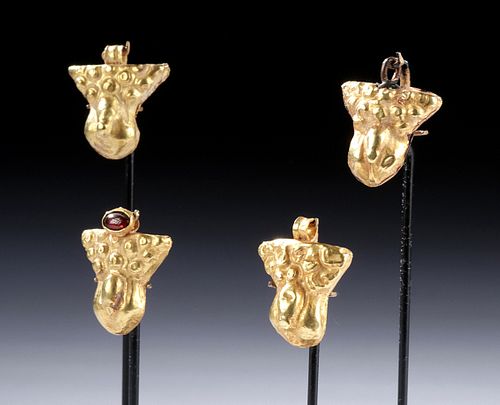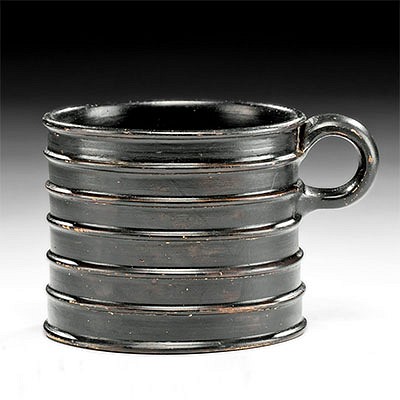Rare Set Roman 18K+ Gold Pendants (Phallus)
Lot 47b
About Seller
Artemis Gallery
686 S Taylor Ave, Ste 106
Louisville, CO 80027
United States
Selling antiquities, ancient and ethnographic art online since 1993, Artemis Gallery specializes in Classical Antiquities (Egyptian, Greek, Roman, Near Eastern), Asian, Pre-Columbian, African / Tribal / Oceanographic art. Our extensive inventory includes pottery, stone, metal, wood, glass and textil...Read more
Categories
Estimate:
$3,400 - $5,100
Absentee vs Live bid
Two ways to bid:
- Leave a max absentee bid and the platform will bid on your behalf up to your maximum bid during the live auction.
- Bid live during the auction and your bids will be submitted real-time to the auctioneer.
Bid Increments
| Price | Bid Increment |
|---|---|
| $0 | $25 |
| $300 | $50 |
| $1,000 | $100 |
| $2,000 | $250 |
| $5,000 | $500 |
| $10,000 | $1,000 |
| $20,000 | $2,500 |
| $50,000 | $5,000 |
| $100,000 | $10,000 |
| $200,000 | $20,000 |
About Auction
By Artemis Gallery
Mar 12, 2020
Set Reminder
2020-03-12 10:00:00
2020-03-12 10:00:00
America/New_York
Bidsquare
Bidsquare : Ancient / Ethnographic Around The World
https://www.bidsquare.com/auctions/artemis-gallery/ancient-ethnographic-around-the-world-4957
Ancient art from Egypt, Greece, Italy and the Near East, as well as Asian, Fossils, Pre-Columbian, Native American, African / Tribal / Oceanic, Spanish Colonial, Russian Icons, Fine art, much more! Artemis Gallery info@artemisgallery.com
Ancient art from Egypt, Greece, Italy and the Near East, as well as Asian, Fossils, Pre-Columbian, Native American, African / Tribal / Oceanic, Spanish Colonial, Russian Icons, Fine art, much more! Artemis Gallery info@artemisgallery.com
- Lot Description
Roman, Imperial Period, ca. 1st to 3rd century CE. A fascinating ensemble of 18K+ gold phallus pendants, one also presenting a red garnet cabochon in a bezel. Phalluses were popular symbols in ancient Rome and, when depicted in a disembodied form like these examples, were used as what Pliny wrote of as a "medicus invidiae" to ward against the evil eye. Each form was skillfully formed from hammered gold sheet. The front faces of each pendant were meticulously modeled with exceedingly naturalistic details. An intriguing ensemble of phallic amulets that were worn as a symbol of virility as well as protection from evil. Size: pendant w/ garnet measures .75" W x .875" H (1.9 cm x 2.2 cm) and all are about the same size ; the garnet cabochon measures .25" W x .125" H (0.6 cm x 0.3 cm); total weight: 5 grams; gold quality: 81% gold, equivalent to 18K+.
Scholars believe that phallic amulets like these were most likely worn by Roman soldiers, since they were intended to ward off evil and this practice was not a regional religious practice. These examples are relatively rare; other ancient phallic amulets discovered in Great Britain were made of base metals. In contrast, these four phallus pendants are made of precious 18K+ gold, and one includes a beautiful garnet cabochon.
Provenance: private East Coast, USA collection; ex-Frances Artuner collection, Belgium, collected in the 1960s
All items legal to buy/sell under U.S. Statute covering cultural patrimony Code 2600, CHAPTER 14, and are guaranteed to be as described or your money back.
A Certificate of Authenticity will accompany all winning bids.
We ship worldwide and handle all shipping in-house for your convenience.
#149956Minute scuffs/nicks to garnet cabochon that are difficult to see with the naked eye. Minor indentations to the gold repousse details and bezel for garnet. Back upper corner of gold sheet on #3 is folded back. Gold loop on #3 was replaced with a bronze loop. Labels with handwritten numbers 1-4 on the versos.Condition
- Shipping Info
-
All shipping is handled in-house for your convenience. Your invoice from Artemis Gallery will include shipping calculation instructions. If in doubt, please inquire BEFORE bidding for estimated shipping costs for individual items.
-
- Buyer's Premium



 EUR
EUR CAD
CAD AUD
AUD GBP
GBP MXN
MXN HKD
HKD CNY
CNY MYR
MYR SEK
SEK SGD
SGD CHF
CHF THB
THB














